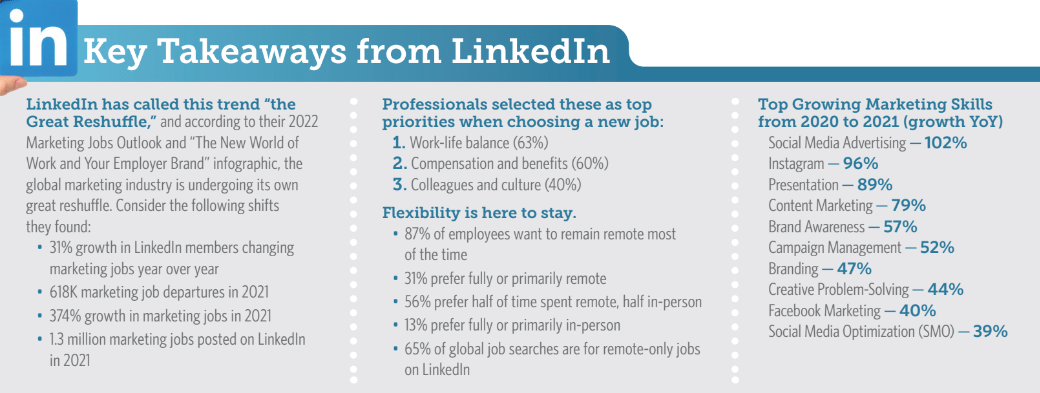Given how pervasive it has become in conversations about economic trends, it’s surprising that the Great Resignation was coined just over a year ago. Psychologist Anthony Klotz, a professor formerly at Texas A&M’s Mays Business School and now at UCL School of Management in London, created the term to describe the rapid increase of employee resignations that began in 2021 and shows no signs of abating. How can your organization protect itself? In the words of executive recruiter Jerry Bernhart, by “understanding the strategic importance of human capital.”
During the first four months of 2022 (January through April), more than 17.5 million Americans voluntarily left their jobs, according to the US Bureau of Labor Statistics. If that doesn’t seem especially high, consider this: that number represents 72 percent of the total 24.4 million “job separations” that occurred during those months. And those 17.5 million job separations were the result of workers quitting, of their own accord, with layoffs and firings accounting for the other 28 percent.
Accommodation and food services as well as the retail sector are experiencing the highest quit rates—5.6 and 4.2 percent, respectively, in April 2022. But professional and business services, which include marketing, are not immune. During the first four months of the year, the quit rate in that sector rose from 3.2 percent in January to 3.7 percent in April.
The Bureau of Labor Statistics doesn’t break out rates specifically for marketing. LinkedIn, however, reported that 618,000 marketers on the platform worldwide left their jobs in 2021, up 31 percent from the previous year and, perhaps more significantly, up 26 percent from 2019, before the COVID-19 pandemic. Of those who left, 52 percent exited the marketing sector entirely. Among North American marketers on LinkedIn, 38 percent left a job last year.
What can you do to keep good employees?
To improve your chances of retaining staff, you need to know the most common reasons employees leave. In an article for MIT Sloan Management Review, Don Sull and Charlie Sull, cofounders of consultancy CultureX, and Ben Zweig, CEO of workforce intelligence firm Revelio Labs, analyzed 34 million online profiles of US workers and came up with these top predictors of employee attrition:
1
Toxic corporate culture, which includes workers feeling disrespected
2
Job insecurity and reorganization
3
High levels of innovation, which often require long hours and heavy workloads among employees
4
Failure to recognize employee performance
5
Poor response to COVID-19
To retain marketing (and other) employees, organizations need to “quit winging it,” says Bernhart, Principal Digital Marketing Recruiter of Bernhart Associates Executive Search, which specializes in the marketing sector. “Few organizations have a true talent-management mindset. They shoot from the hip. They don’t develop their people quickly and effectively. They don’t go the extra mile to keep their top performers, and they don’t remove low performers when they should.”
And because there is no one-size-fits-all way to bolster employee retention, you must make a point of periodically asking team members whether they are satisfied and, if they are not, what you could do to change that. Even if you cannot accommodate all their requests, listening to them is a major element of respecting your employees—and, therefore, mitigating employee churn.

5 Tips for Attracting Employees
No marketing department is immune from employee turnover. And amid the Great Resignation, it’s an employee’s—not an employer’s—market. “The sheer number of marketing jobs available gives marketers more options than ever before,” says Bernhart. “Marketing has many subspecialties, and for some of those job categories, the competition is fierce. Employees can be more selective. They don’t have to relocate as much as they used to. Many get multiple offers. Many are counteroffered. I can’t tell you how many calls I’ve received from employers with sob stories about how they came within an inch of hiring a great candidate, only to lose them.”
To attract and win over ideal candidates, keep these tips in mind:
1
Make sure your offer is competitive. Maybe in the past you were able to offer lower salaries or fewer benefits because you were in a “glamour” industry such as entertainment. That’s much less likely now.
A key aspect of respect is recognizing employees not only as staff but also as individuals for whom work is just one aspect of their lives—albeit an important one. Employees can achieve a more optimal work-life balance and feel respected when employers enable flexibility through remote or hybrid work scenarios or flex hours.
2
Look for marketers outside your industry sector. Companies used to seek out marketers who had experience in their particular industry. Today many, if not most, marketing specialties, such as social media, SEO, or email, are highly transferrable across market sectors.
3
Offer employees referral bonuses. Tech departments have used this tactic for years, and it’s becoming more common among other sectors as well. Just be sure that the bonus is payable only after the new hire has been employed for at least three months with a favorable performance rating.
4
Offer sign-on bonuses. This is another tool borrowed from the tech sector. Again, put in place criteria regarding tenure and performance.
5
Be flexible, especially regarding remote work. “Around one-quarter of the searches I’ve been working on in recent months have been remote. Pre-pandemic, it was no more than maybe 5 percent,” Bernhart says. “That being said, many employers I am working with now who want new hires to be in office seem willing to flex for the right candidate.”








